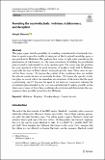Revealing the counterfactuals : molinism, stubbornness, and deception
Abstract
This paper argues that the possibility of revealing counterfactuals of creaturely freedom to agents in possible worlds forming part of God's natural knowledge poses a new problem for Molinism. This problem best comes to light when considering the phenomenon of stubbornness, i.e., the conscious refusal of fulfilling the providential plan revealed to and intended for us by another agent. The reason why this problem has gone unnoticed is that the usual instances of prophecy dealt with by Molinists (especially the story of Peter's denial) are highly specific cases. These cases are special for three reasons: (1) because the content of the revelations does not include the relevant counterfactuals of creaturely freedom, (2) because the specific revelation plays no causal role in the immediate circumstances of the action that the agent is performing, and (3) because the agent is not intent on consciously refusing the providential plan intended by the relevant counterfactual. I explore possible worlds where one or more of these three conditions do not obtain and demonstrate the consequences these possible worlds have for Molinists.
Citation
Moravec , M 2022 , ' Revealing the counterfactuals : molinism, stubbornness, and deception ' , International Journal for Philosophy of Religion , vol. 92 , 92 , pp. 31-48 . https://doi.org/10.1007/s11153-021-09824-9
Publication
International Journal for Philosophy of Religion
Status
Peer reviewed
ISSN
0020-7047Type
Journal article
Description
The writing of this paper was supported by funding from a studentship hosted by the Arts and Humanities Research Council Doctoral Training Partnership and Pembroke College, Cambridge (Grant number: AH/L503897/1, grant recipient: Matyáš Moravec).Collections
Items in the St Andrews Research Repository are protected by copyright, with all rights reserved, unless otherwise indicated.

